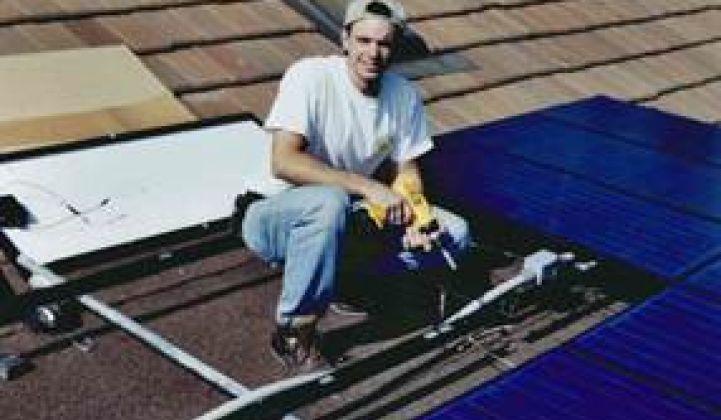Fifteen years ago, Cal Poly Environmental Engineering graduate Judy Staley and former Air Force electronics technician Fred Sisson were looking for a "renewable energy concept" business that would make a difference. With a $100,000 mortgage on Staley’s mother’s house and credit cards, they built REC Solar into a leading system installer.
“I was always fascinated by solar power because it has no moving parts and is such a long-lasting technology,” Staley recalled. It was 1997. California had just instituted its net metering law. The Emerging Renewables Program, the policy precursor to today’s California Solar Initiative, was in the works. “Our goal became getting as much solar installed as possible. We started with residential customers and ramped up to doing commercial customers.”
“My first job out of school was at Diablo Canyon Nuclear Power Plant,” remembered REC VP and General Manager Ethan Miller, who came aboard in 2001 as one of the company's first salaried employees. “But I didn’t think that was the future of energy.”
When she and Sisson were able to pay salaries, Staley said, she realized the business was viable. She and Sisson were married then. They divorced later but remain “good friends.”
“We started by providing unique, custom solutions for customers’ needs,” Miller said. “If you wanted a wind system with battery backup and solar, too, and a generator, we could do it. But we realized we couldn’t offer a custom solution for everybody. I knew the business was viable when we were able to say ‘no’ to a few projects and focus on a specialized offering. That was in the 2003 to 2004 timeframe.”
“We were one of the first companies in California to focus on grid-connected solar systems,” Staley remembered. “Around late 2004-early 2005, we needed capital and I wanted somebody with more experience than me as President and CEO.” Angiolo Laviziano, previously with Conergy in Germany, took the job and invested in the company. They formed Mainstream Energy Corporation, now parent to both REC Solar and AEE Solar, the organization’s distribution arm.
REC Solar now has seventeen offices in six states and over 800 employees. It has installed 120-plus megawatts of solar at over 8,700 sites. In 2011, it installed nearly five times as many megawatts as in its first ten years.

But, Miller said, “we have stepped back from that growth trajectory. We have to be careful not to lean too far in. We’re dealing with much bigger numbers than in the early years but the growth rate has come down to a manageable level.” The emphases remain on “bringing solar to the mainstream” and on “a long term view of quality and customer service.”
Quality, Miller said, “means making sure that the systems will produce energy for the next twenty years.” Though REC Solar “placed some of the first purchase orders” with many of today’s panel makers and has long-term relationships with some, products are still selected cautiously.
Decisions on materials are made by REC Solar’s supply chain and engineering groups, Miller said. Panel selection is based on manufacturer specifications but also on whether the manufacturer can get the product delivered on time and on what the contractual and warranty terms are. “Price is important, but if we don’t take a holistic, end-to-end view, we are not going to get the lowest cost at the end of the day.”
REC Solar tests systems on its headquarters roof. “We have six different systems now,” Miller said. “I have had systems off-warranty, systems that I have seen through their full life cycle, ten-year-old systems without even one service issue, and technologies with a 100-percent failure rate.”
The company is typically not “the first on the bandwagon” with new technologies, Miller said, but he does foresee “an opportunity for some kind of smart module, whether with a microinverter or power optimizer, that hopefully will improve production and reduce costs.”
The company has moved to ballasted, non-penetrating racking for commercial installations.
The 2016 investment tax credit ratcheted down to 10 percent will not hurt solar, Staley said, if the total installation cost continues to fall. She expects financing to become more creative. “There was always the acknowledgement that better financing was needed,” she recalled. “Early on, before PPAs, we talked with banks about different loan programs to expand customers’ options. PPA models opened things up quite a bit.”
REC Solar was third-party-ownership (TPO) pioneer Sunrun’s “first partner ever,” Miller said. It continues to work “primarily, though not exclusively, with Sunrun.” TPO financing currently accounts for “roughly 80 percent of REC Solar’s residential installations and about half of its commercial installations.”
“Costs will continue to come down,” Miller predicted. “And consumer behavior will shift again. At a certain price point, you stop using financing vehicles. That is probably what keeps the leaders of the companies that do TPO awake at night. When Judy and I first started, the average home system might be a $40,000 purchase. Now it’s 30 percent of that and financed at no money down. The next step will be another total shift. It is on the horizon. It will become more like buying home security or windows.”



